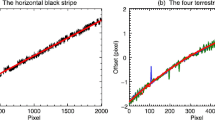Abstract
Reconstruction of radio images of the Sun obtained by the Siberian Solar Radio Telescope (SSRT) encounters two main problems. First, since the solar radio images at a wavelength of 5.2 cm have a high contrast, the amplitude–phase distribution in the antenna–feeder section should be known with a very high accuracy. Second, since such images comprise not only bright compact components but also low-contrast diffuse areas, there is a problem of deconvolution of these diffuse sources, which is inherent to the CLEAN algorithm. To solve the first problem, we determine the amplitude–phase distortions by an iterative analysis of the image itself, in which the opposite sidelobes of the point-source response are compared. To suppress the influence of other sources on the response, we analyze several compact sources. The phase distortions are determined from the asymmetry of the sidelobes, and the amplitude distortions, from sidelobe values. The image is corrected in the spatial-spectrum domain after each iteration. On the one hand, the problems encountered when reconstructing extended sources are related to the fact that the CLEAN algorithm requires significant computer resources. On the other hand, reconstructing images of extended areas requires that the number of cycles of this algorithm should be increased. Another problem consists in the fact that the use of the same “clean” antenna pattern for reconstructing compact and extended sources results in appearance of high-frequency distortions of the latter sources. If the CLEAN algorithm is applied, then the computer resources are mainly spent to shift the pattern and to find the maximum of the initial image. We decrease the time necessary for shifting the pattern by excluding the points near the zero value from the antenna-pattern data set and by sorting the remaining data points. The time of finding the maximum was decreased by using a local search window. In addition, we use a number of cutoff levels and search the next maximum in the whole image only after reconstructing the windowed image down to the current cut level. To reconstruct bright compact sources, we use the ”clean” antenna pattern close to the ideal pattern. To reconstruct low-contrast diffuse areas, we use the model patterns obtained by convolving the antenna pattern with the images of extended sources.
Similar content being viewed by others
REFERENCES
G. B. Gel'freikh, D. V. Korol'kov, G. Ya. Smol'kov, and T. A. Treskov, in: Results of Observations and Studies during the International Year of the Quiet Sun, No. 4 [in Russian], Nauka, Moscow (1967), p. 168.
J. Högbom, Astrophys. J. Suppl. Ser., 15, 417 (1974).
S. V. Lesovoy, V. I. Vasin, and V. G. Zandanov, “Determination of the phase characteristic of the antenna-feeder section of the SSRT,” Preprint No. 5-98 [in Russian], Inst. for Solar-Terrestrial Phys. of the Siberian Branch of the Russian Acad. Sci., Irkutsk (1998).
B. G. Clark, Astron. Astrophys., 89, 377 (1980).
B. G. Clark, Astron. Astrophys., 89, 417 (1980).
Author information
Authors and Affiliations
Rights and permissions
About this article
Cite this article
Lesovoy, S.V. Reconstruction of Radio Images of the Sun Obtained by the Siberian Solar Radio Telescope. Radiophysics and Quantum Electronics 45, 865–871 (2002). https://doi.org/10.1023/A:1023512928805
Issue Date:
DOI: https://doi.org/10.1023/A:1023512928805




